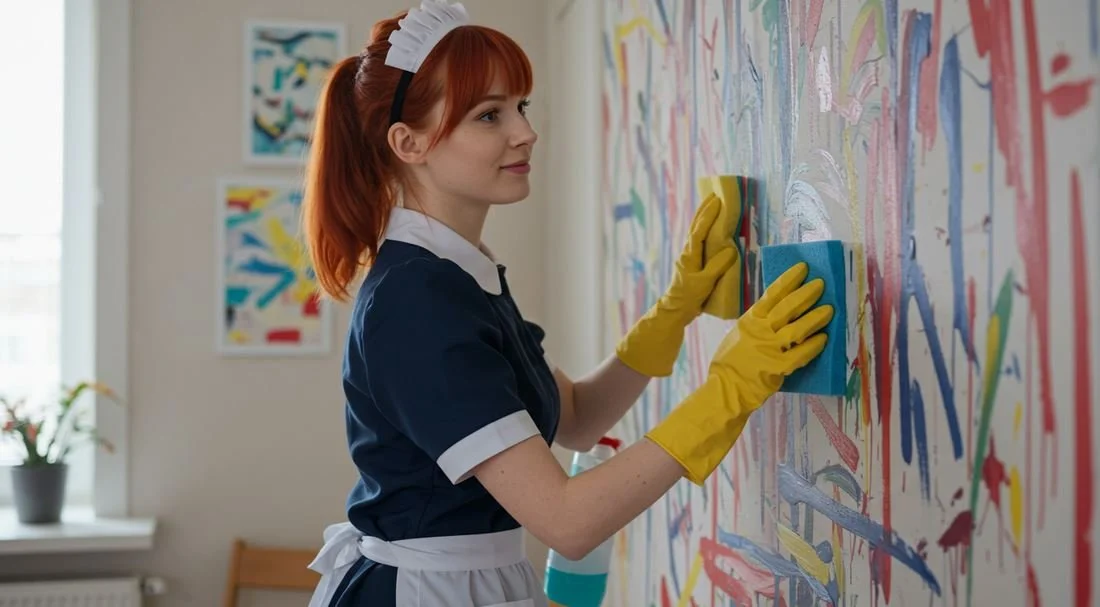How To Get Acrylic Paint Off The Wall (Without Wrecking It)
You’re painting. Maybe it’s a DIY art project, or you’re freshening up a room. Then oops - your hand slips, and suddenly there’s a streak of acrylic paint on the wall that definitely wasn’t part of the plan. Or maybe it’s your kid’s new "mural."
Either way, there’s no need to panic!
Acrylic paint might seem like it’s glued to the wall for life, but it can come off. You just need to know the right way to remove it without destroying your wall in the process.
In this quick guide, I'll show you how to get acrylic paint off the wall in detail. This works on both wet and dried acrylic paint.
What You’ll Need
Before you can start removing acrylic paint off the wall, gather your supplies. You don’t need anything fancy, and there’s a good chance you already have most of these at home:
Warm water and mild dish soap
Soft sponge or microfiber cloth
Rubbing alcohol or acetone (nail polish remover works)
Plastic scraper, putty knife, or old credit card
Magic Eraser (just one is fine)
Optional: paint thinner, graffiti remover (only if it’s really bad)
Extra wall paint for touch-ups
Alright, let’s start with the easiest fix: when the paint is still wet.
If all that sounds like a lot, you can always hire a home cleaning service to do it.
How To Get Wet Acrylic Paint Off Walls
If the acrylic paint is still fresh, you’re in luck. That’s the easiest time to get it off, and it usually doesn’t take more than five minutes.
Grab a paper towel or clean cloth and gently blot the paint. Don’t rub it around as that just smears the mess into a bigger mess. Instead, pat it and lift as much as you can off the surface.
If the paint hasn’t soaked in, it should come up pretty easily.
Next, mix a few drops of dish soap into some warm water. Dip a sponge or cloth in the soapy water, wring it out so it’s damp (not soaking) and gently wipe the area.
A couple of passes should do it. If needed, rinse the sponge and go again.
While you’re at it, if you see any boogers on the walls, you can clean it with this too.
Once the paint’s gone, take a clean, damp cloth to wipe off any soap residue. Dry it off with a towel, step back, and admire your good-as-new wall.
How To Remove Dried Acrylic Paint Off Walls
Dried acrylic paint is a different story. Once it hardens, it clings to the surface like it was meant to live there. But don’t worry, you’ve still got options.
Here’s to how to get dried acrylic paint off the wall step by step:
#1 Scrape Off What You Can
First up, grab something with a flat edge - like a plastic putty knife or an old credit card.
You want to gently lift the dried paint without gouging the wall underneath. Don’t use metal tools here unless you’re okay with scratching the surface.
Hold the scraper at a slight angle and slowly work it under the edge of the paint. Try to flake or peel off as much as you can. Sometimes, if the paint layer is thick enough, it’ll come off in chunks. That’s a win.
If nothing’s budging, don’t force it.
#2 Dab On Rubbing Alcohol Or Acetone
Grab a cotton ball, Q-tip, or soft cloth and apply a little rubbing alcohol or acetone to the dried paint spot. These both help break down acrylic and make it easier to remove.
Nail polish remover works too which is usually just diluted acetone.
Before you go all-in, test it in a hidden corner of the wall. You don’t want to end up removing the actual wall paint in the process. If it looks fine after a few minutes, go ahead and apply it directly to the dried paint.
You don’t need to soak it - just enough to get the surface damp.
#3 Let It Soften
Give it a minute or two. The alcohol or acetone needs a little time to do its thing.
You’ll know it’s working when the paint starts to feel tacky or rubbery.
If it still feels rock hard after a few minutes, you can reapply a bit more. Don’t rush it. You’re not trying to melt the wall - just loosen the grip that paint has on the surface.
#4 Wipe Or Scrub Gently
Now that the paint has softened, it’s time to wipe it off.
Use a clean cloth or sponge and gently scrub the area. You should see the paint start to come off in little streaks. Go slow and apply light pressure.
If the paint isn’t coming off, don’t keep scrubbing like crazy, just go back and dab on a bit more alcohol or acetone and wait again.
Once you’re satisfied, wipe the wall down with clean water to get rid of any leftover chemicals.
#5 Try A Magic Eraser For Stubborn Spots
If you’re still seeing paint streaks, you can use a Magic Eraser.
These things are awesome for cleaning up weird stains, and they can lift leftover acrylic without destroying your wall, but you need to be gentle.
Wet the eraser slightly and go over the spot using soft, circular motions.
Check the wall paint underneath as you go. If it’s holding up, keep going. If it starts to fade or peel, stop and move on to another option.
Magic Erasers are surprisingly strong, so a light touch really is all you need.
#6 Use Paint Thinner Or Graffiti Remover (Last Resort)
If all else fails and only if everything above hasn’t worked, you can try paint thinner or a graffiti remover. This is extreme cleaning and the nuclear option, though.
These products are harsh and can easily damage your wall paint, so tread carefully.
Always, always do a spot test first. Wear gloves. Work in a well-ventilated area. And don’t go pouring it all over the place - just use a small amount on a cloth and dab gently.
Honestly, this step is rarely needed unless the acrylic paint has been there forever or someone went wild with thick layers.
What If The Wall Paint Comes Off?
So, the paint came off… and now the wall underneath is looking rough.
Don’t worry, it happens. When you’re working with scrapers, chemicals, or even just a Magic Eraser, it’s super easy to take off more than you meant to.
If the damage is small, a little touch-up paint can do the trick. Most hardware stores can color-match if you bring in a sample or even a clear photo of your wall.
Use a small brush or sponge to dab the paint back on. Feather the edges so it blends in smoothly.
If you’ve got larger patches of missing paint, you might want to sand the area lightly and use primer before repainting.
It sounds like a lot, but it’s really not. Just take your time and treat it like a mini DIY project.
Bottom Line
Accidents happen. Acrylic paint ends up on walls all the time. The good news is that you don’t have to live with it, and you don’t need to repaint the whole room either.
Fresh paint? Easy fix with soap and water.
Dried paint? Take it step by step - scrape, soften, wipe, repeat. And only reach for the heavy-duty stuff if you’ve exhausted the gentle options.
Your wall’s going to be just fine. Probably better than it was before you even noticed the paint!

